Brutalism: An Architectural Aesthetic Redefined in Landscape Design
Brutalism, the architectural movement that rose to prominence in the mid-20th century, is often characterized by its raw, uncompromising aesthetic. This design philosophy, which prioritized exposed concrete, bold geometric forms, and a sense of industrial strength, has found a natural expression in the world of landscape design. This renewed interest in brutalism has not only permeated the world of architecture but has also found its way into the realm of landscape design, where designers are reinterpreting the brutalist ethos to create striking, minimalist plant landscapes.
The brutalist approach manifests through the use of structural, sculptural vegetation and the strategic incorporation of hard, natural materials like stone and metal. By embracing the inherent beauty of these bold, unapologetic elements, brutalist garden design creates a sense of visual weight and permanence, evoking a rugged, almost monumental quality. Just as the Brutalist architectural style sought to challenge traditional notions of beauty, brutalist plant landscapes challenge the conventional idea of a lush, ornamental garden, instead prioritizing the raw, unadorned charm of the vegetation itself.
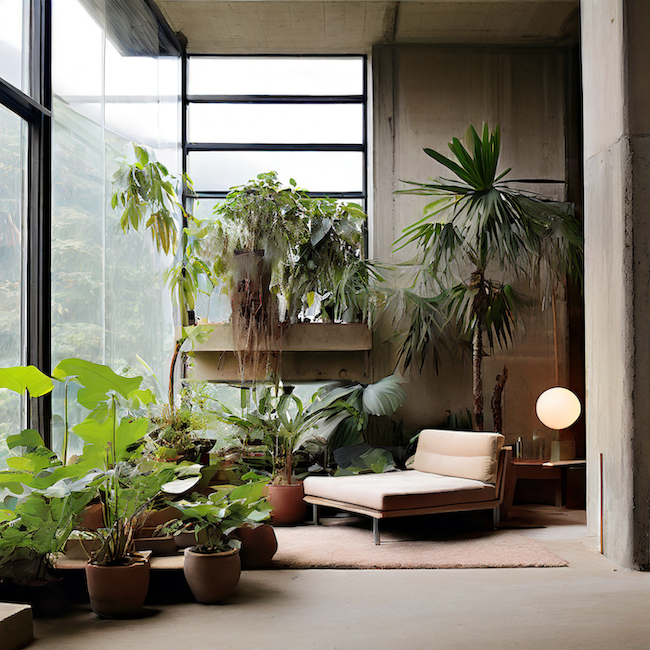
A growing trend in landscape design has emerged that embraces the beauty of simplicity. Brutalist and minimalist plant landscapes offer a refreshing alternative to the traditional lush, ornamental gardens, captivating the hearts and minds of design enthusiasts and nature lovers alike.
These pared-down, architectural approaches to outdoor spaces celebrate the inherent elegance of form, texture, and negative space, creating striking, low-maintenance havens that are as visually compelling as they are sustainable.

Defining Brutalist and Minimalist Plant Landscapes
Brutalist and minimalist plant landscapes share a common thread – a focus on simplicity, clean lines, and a deliberate absence of excess. However, these two design styles differ in their specific aesthetic characteristics:
Brutalist Plant Landscapes
Inspired by the brutalist architectural movement, brutalist plant landscapes feature bold, geometric shapes, often using materials like concrete, stone, or metal. These landscapes eschew the delicate, flowing forms of traditional gardens in favor of a rugged, industrial-inspired look. The use of hardy, sculptural plants, such as succulents, cacti, and grasses, further emphasizes the stark, unapologetic nature of this design approach.
Minimalist Plant Landscapes
Minimalist plant landscapes take a more pared-down, zen-like approach, focusing on clean lines, negative space, and the essential elements of nature. These designs often utilize a limited palette of plants, carefully placed to create a sense of balance and harmony. The emphasis is on the individual plant’s form, texture, and the relationship between each element, rather than on creating a lush, visually-overwhelming display.

Defining Brutalist and Minimalist Plant Landscapes
Brutalist and minimalist plant landscapes share a common thread – a focus on simplicity, clean lines, and a deliberate absence of excess. However, these two design styles differ in their specific aesthetic characteristics:
Brutalist Plant Landscapes
Inspired by the brutalist architectural movement, brutalist plant landscapes feature bold, geometric shapes, often using materials like concrete, stone, or metal. These landscapes eschew the delicate, flowing forms of traditional gardens in favor of a rugged, industrial-inspired look. The use of hardy, sculptural plants, such as succulents, cacti, and grasses, further emphasizes the stark, unapologetic nature of this design approach.
Minimalist Plant Landscapes
Minimalist plant landscapes take a more pared-down, zen-like approach, focusing on clean lines, negative space, and the essential elements of nature. These designs often utilize a limited palette of plants, carefully placed to create a sense of balance and harmony. The emphasis is on the individual plant’s form, texture, and the relationship between each element, rather than on creating a lush, visually-overwhelming display.
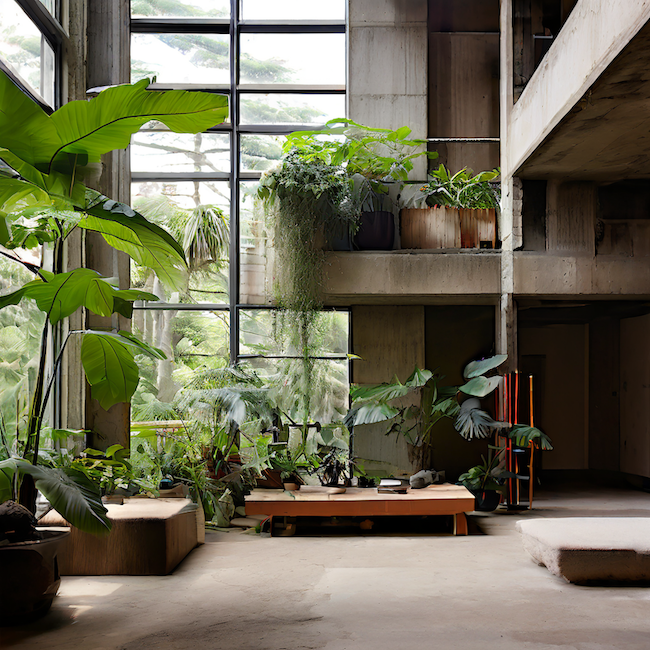
Designing Brutalist and Minimalist Plant Landscapes
When creating a brutalist or minimalist plant landscape, the key is to focus on balance, proportion, and the careful curation of each element. Some essential design principles to consider include:
Plant Selection: Choose hardy, sculptural plants with strong forms, interesting textures, and a limited color palette to maintain the minimalist aesthetic.
Geometric Shapes: Incorporate clean, bold geometric shapes, such as rectangles, squares, or circles, to define the overall layout and structure of the landscape.
Hardscaping: Leverage materials like concrete, stone, or metal to create striking, architectural features that complement the plant palette and design.
Negative Space: Embrace the power of empty space, allowing it to act as a foil to the carefully placed plants and hardscaping elements.
Spatial Arrangement: Experiment with asymmetrical, geometric layouts and the strategic use of negative space.
Maintenance: Opt for low-maintenance plants and materials that require minimal upkeep, allowing you to enjoy your outdoor oasis with ease.
Balanced Composition: Ensure a harmonious interplay between the various components, creating a sense of visual balance and rhythm throughout the landscape.
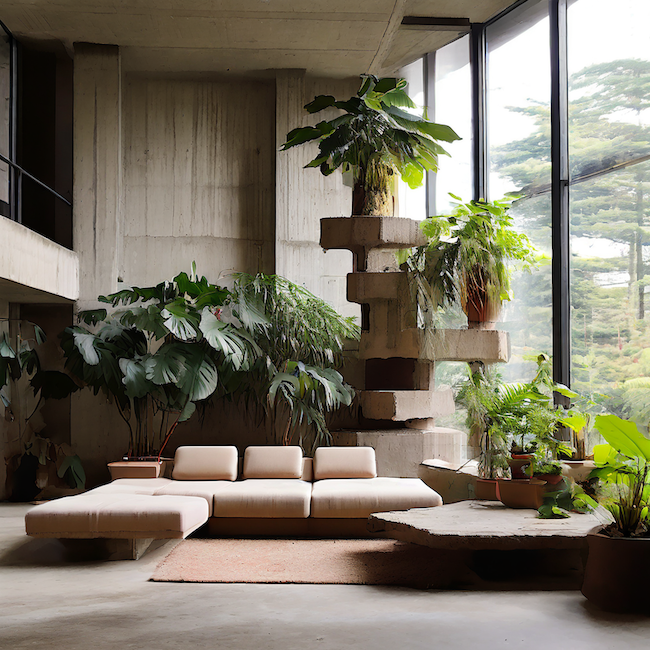
Embracing the Beauty of Simplicity
In a world that often values excess and opulence, brutalist and minimalist plant landscapes offer a refreshing alternative, celebrating the inherent beauty of simplicity, form, and the natural world. By embracing these design approaches, homeowners, landscapers, and designers can create stunning, low-maintenance outdoor havens that not only delight the senses but also foster a deeper connection to the environment.
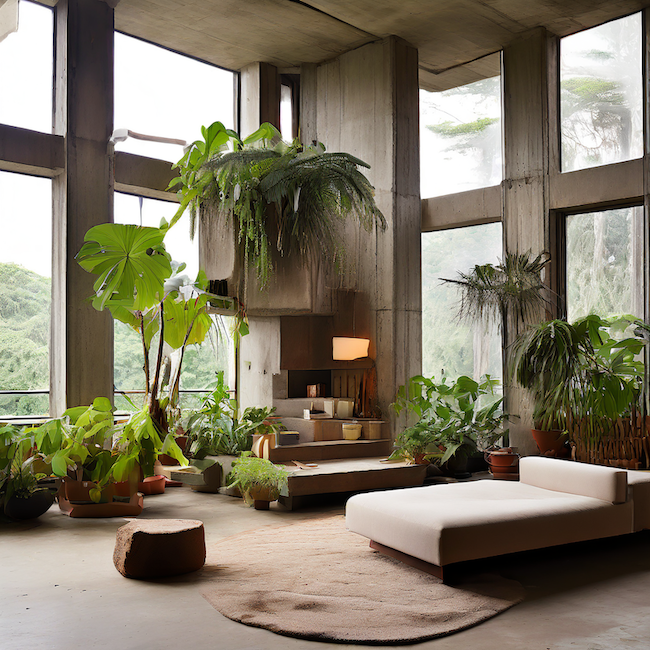
Here are some specific plant options that would thrive in brutalist and minimalist plant landscapes:
Brutalist Plant Landscape:
- Succulents:
- Agave ‘Blue Glow’
- Echeveria ‘Perle von Nürnberg’
- Sempervivum ‘Cobweb’
- Opuntia ‘Santa Rita’ (prickly pear)
Succulents, with their thick, geometric forms and muted color palettes, are quintessential choices for a brutalist garden. Their drought-tolerance and architectural qualities make them an ideal fit.
- Grasses:
- Miscanthus sinensis ‘Morning Light’
- Stipa tenuissima (Mexican feather grass)
- Pennisetum ‘Burgundy Bunny’ (fountain grass)
- Calamagrostis ‘Karl Foerster’ (feather reed grass)
Ornamental grasses add movement, texture, and vertical interest to a brutalist design. Their linear forms and soft, flowing textures contrast beautifully with the rigid, geometric shapes of other plant species.
- Yucca:
- Yucca filamentosa ‘Bright Edge’
- Yucca rostrata
- Yucca gloriosa ‘Variegata’
The spiky, sword-like leaves of Yucca plants perfectly embody the bold, sculptural qualities of brutalist design. Their architectural presence and drought tolerance make them a natural choice.
- Cacti:
- Opuntia ‘Burbank’ (prickly pear)
- Echinocactus grusonii (barrel cactus)
- Cereus hildmannianus (torch cactus)
Cacti, with their angular shapes and rugged textures, seamlessly integrate into the industrial aesthetic of a brutalist garden. Their low-maintenance requirements are an added benefit.
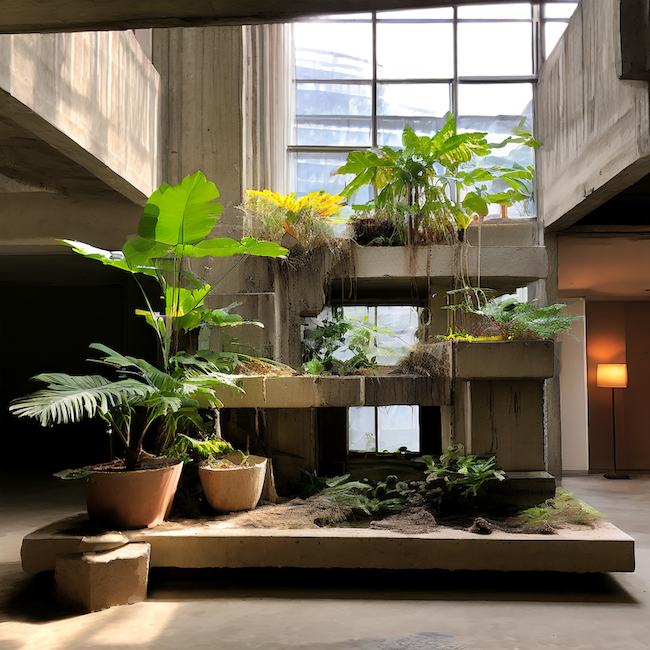
Minimalist Plant Landscape:
- Ornamental Grasses:
- Miscanthus sinensis ‘Gracillimus’
- Carex ‘Ice Dance’
- Stipa gigantea (giant feather grass)
- Festuca glauca ‘Elijah Blue’ (blue fescue)
Grasses, with their linear forms and subtle textures, are a natural choice for a minimalist plant landscape. Their tranquil, calming presence is ideal for this design style.
- Succulents:
- Echeveria ‘Afterglow’
- Sedum ‘Autumn Joy’
- Aeonium ‘Kiwi’
- Crassula ovata (jade plant)
Succulents, with their geometric shapes and muted color palettes, integrate seamlessly into a minimalist garden. Their low-maintenance nature is an added benefit.
- Low-growing Perennials:
- Lavandula angustifolia (English lavender)
- Thymus vulgaris (common thyme)
- Salvia nemorosa ‘Caradonna’
- Erigeron karvinskianus (fleabane)
These delicate, low-growing perennials can be used to create a cohesive, understated groundcover in a minimalist landscape, with their subtle flowers and textural foliage.
- Native Plants:
- Echinacea purpurea (purple coneflower)
- Rudbeckia fulgida (black-eyed Susan)
- Penstemon digitalis (foxglove beardtongue)
- Muhlenbergia capillaris (pink muhly grass)
Choosing to use native plant species not only supports local ecosystems but also aligns with the minimalist design philosophy of working in harmony with the natural environment.
When selecting plants for your brutalist or minimalist plant landscape, consider factors like mature size, growth habit, and color palette to ensure a cohesive and visually striking design. By carefully curating your plant selection, you can create an outdoor oasis that reflects the essence of these captivating landscape styles.
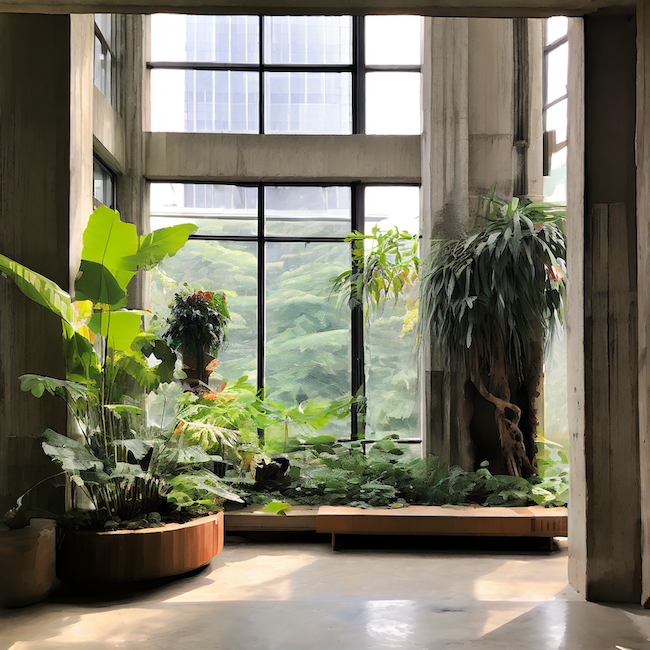
The color palettes used in brutalist and minimalist plant landscapes play a crucial role in setting the overall tone and aesthetic. Here are some recommended color schemes that work particularly well in these design styles:
Brutalist Plant Landscape Color Palettes:
- Earthy Tones:
- Shades of gray, ranging from charcoal to soft, weathered grays
- Warm browns and taupes
- Accents of rust, terracotta, and ochre
This earthy color palette perfectly complements the raw, industrial materials and sturdy, geometric forms of brutalist design. The muted tones create a sense of ruggedness and permanence.
- Monochromatic Greens:
- Various shades of green, from deep, olive tones to pale, silvery hues
- Contrasting textures and shapes to create visual interest
By focusing on a monochromatic palette of greens, the brutalist garden emphasizes the structural qualities of the plants, allowing their form and foliage to take center stage.
- Pops of Vibrant Color:
- Bright, saturated hues like cobalt blue, crimson red, or mustard yellow
- Used sparingly to add unexpected bursts of color and visual contrast
While the overall palette should remain subdued, the occasional splash of vibrant color can add a dynamic, almost surprising element to a brutalist plant landscape.
Minimalist Plant Landscape Color Palettes:
- Soft Neutrals:
- Shades of white, cream, and pale gray
- Accents of soft, muted greens and blues
This serene, neutral-based palette creates a sense of calm and simplicity, allowing the subtle variations in texture and form to take precedence.
- Monochromatic Blues and Greens:
- Ranging from deep, inky tones to soft, sea-glass hues
- Carefully curated to highlight the nuances of each plant’s foliage
By limiting the color palette to harmonious shades of blue and green, the minimalist garden invites the viewer to focus on the intricate details and soothing transitions between the various plant specimens.
- Contrasting Hues:
- Pairing complementary colors, such as warm and cool tones
- Examples: pink and lime green, orange and blue, purple and yellow
While minimalist designs often favor more muted palettes, the strategic use of contrasting hues can add a touch of visual interest and dynamism to the landscape.
Regardless of the specific color scheme you choose, the key is to maintain a sense of cohesion and restraint. In both brutalist and minimalist plant landscapes, the colors should work in harmony to highlight the structural qualities and inherent beauty of the carefully curated plant material.
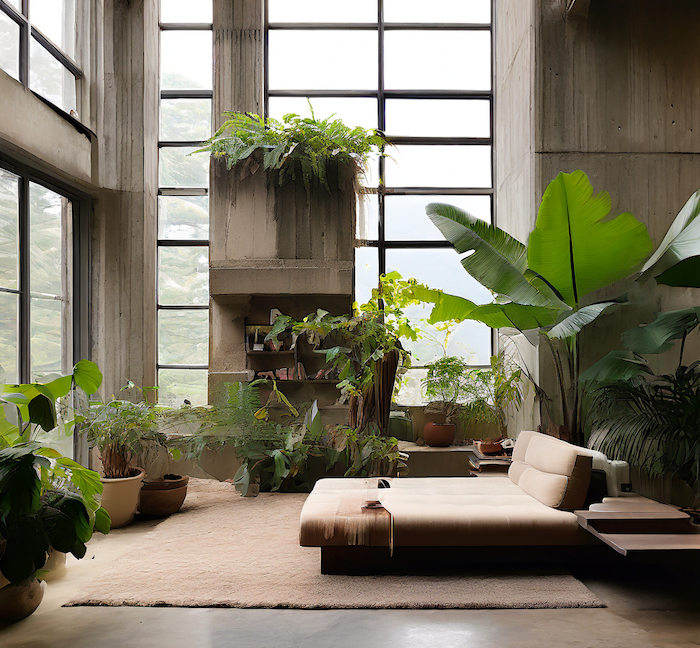
DecorWorks showcases the latest trends and tips in home decor and interior design to inspire your best life. We curate architecture and design inspiration for global audiences, and show you practical tips to create any imaginable space.

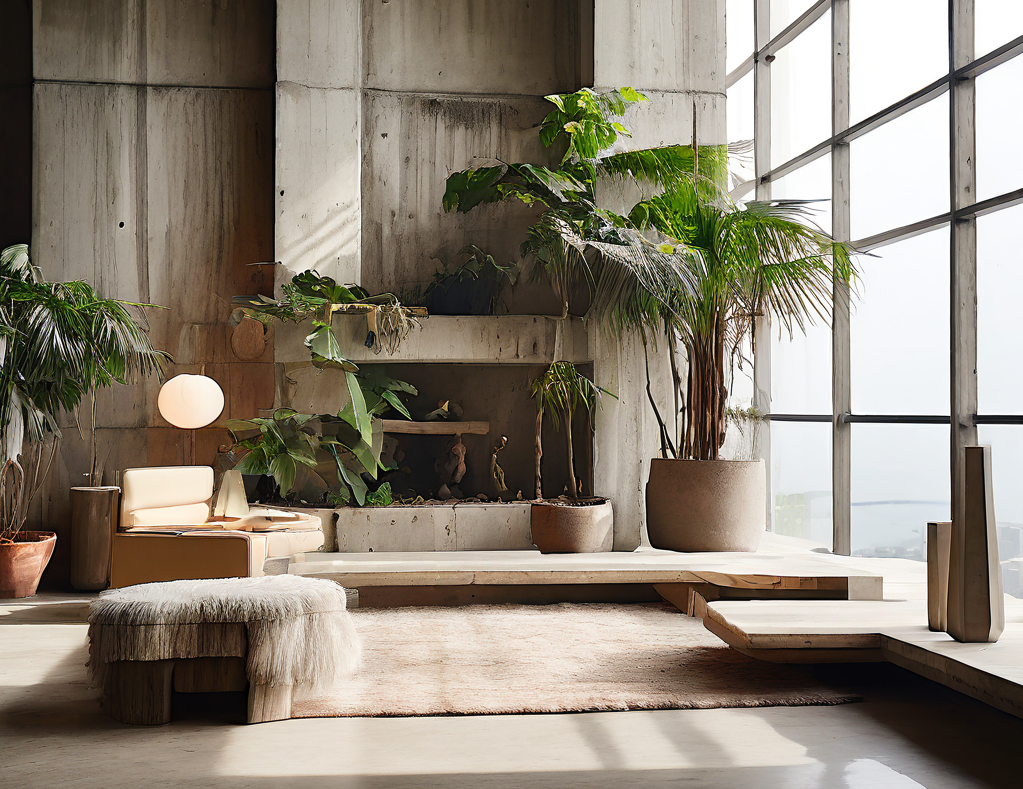

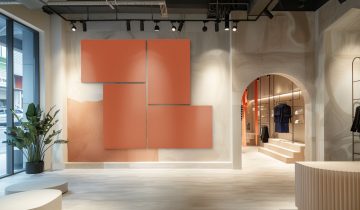

 No products in the cart.
No products in the cart.